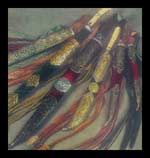|
The purpose of this information is to
attract attention of tourists to cultural heritage of Uzbekistan, the valuable
samples of which are positioned in the Bukhara state museum. Many thousands of
guests have already visited the museum, but we must establish a fact, that
Uzbekistan still terra incognita for most of the representatives of western
civilization. Unfortunately Russia with its wide history overshadows the history
of less big countries of former USSR. Therefore our desire is to throw light
upon one of the important tourism attractions of present-day Uzbekistan, which
was established in the first decades of 20 century. In order to achieve of that
goal an article of G.N. Kurbanov (see copyright information)
is cited below.
The Bukhara State museum was
founded in November 10, 1922.
The permanent exposition of the museum represents the nature and history of the
area, the development of folk decorative and applied art. The museum has a rich
collection of more than 60 thousand exhibits. Among them is the archeological
collection reflecting different stages of history of the ancient Bukhara oasis.
The most valuable are items from the burial mounds dating back to period from
the second century B.C. till first century A. D., a numismatic collection (from
fourth century B. C. till nineteenth century A. D.), earthenware articles of the
Early Middle Ages and of the golden age of Bukhara when the city was a political
and cultural centre of the Samanid state.
Bukhara is the centre for trade and handicraft since times of antiquity. It was
famous for copper-chasing, jeweler?s art, ceramics and the art of gold
embroidery. The 18th-20th century articles made by Bukhara coppersmiths or
"misgars", as they are called here, such as dastshui, oftoba, choidish are
notable for the strict beauty of form and the rhythmic arrangement of patterns.
The jewelers, too, have added a vivid page to the history of artistic treatment
of metal. Bukhara was famed for a variety of forms and perfect technique of
bracelets "das-tpona", "khalka" ear-rings, pendants, belt-buckles and necklaces,
and also for original big articles of jeweler?s art coated with engraving,
niello, enameling of varied colors.
The museum boasts a rich collection of embroidery ? one of the most popular
kinds of folk decorative and applied art. Among them are decorative wall
hangings ? susana, nimsusana. zardevor; bed-spreads or joipush which were
destined, mainly, for the bride's dowry.

Suzana ? a decorative wall-hanging. Bukhara, late 19 th century. Hand
embroidery with woolen threads on a cotton fabric ?mata?, ?jurma? stitch.
Gold embroidery is the predominant part of the Bukhara decorative handicraft.
Visitors to the museum are invariably impressed with the brilliance of
embroidery and filigree of work of gold-embroiders or ?zarduzes? of Bukhara.

Articles of men's gold-embroidered clothes.
Manuscripts played an important role in the life of the society. They carefully
preserved and passed on the varied legacy of written culture of the Bukhara
oasis. The collection of manuscripts at the museum has quite a number of books
on the history, philosophy, literature, natural sciences, and cookery. The
earliest ones date back to the sixteenth century.
The museum is engaged in large-scale scientific-re?search work and collecting of
exhibits. The museum accu?mulates more than two thousand exhibits annually.
More than one million two hundred people visit the Bukhara State
historical-architectural museum and its branches every year.

Pichok ? knives. Bukhara, early 20 th century. Blades ? steel,
engraving; decorated hafts made of metal and bone; sheaths ? leather, brass,
chased.
Related articles:
|









